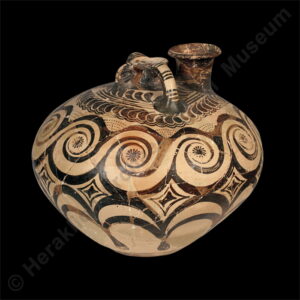
A type of vessel for transporting liquids, also known as a “false-necked amphora”. The hollow “false neck” was sealed before firing and used to handle and carry the vessel more easily, in conjunction with the two or, more rarely, three handles. The real pouring spout, at the side of the neck, was easily sealed with a stopper of clay or perishable materials (cloth, wood or leather) during transport. The false spout relieved the pressure inside the vessel, making it more difficult for the stopper to come away during transport, and thus ensuring the safety of the contents on journeys by land and sea. Stirrup jars, so named because of the way the handles join over the false neck, resembling a stirrup, were a common type of vessel for transporting liquids in the Neopalatial period, becoming particularly popular in Mycenaean times.